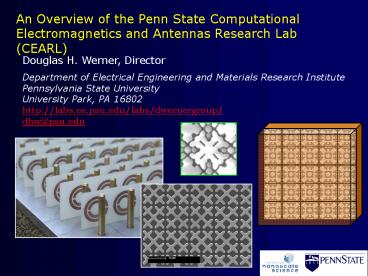Title Bar - PowerPoint PPT Presentation
1 / 15
Title: Title Bar
1
An Overview of the Penn State Computational
Electromagnetics and Antennas Research Lab
(CEARL)
Douglas H. Werner, Director
- Department of Electrical Engineering and
Materials Research Institute - Pennsylvania State University
- University Park, PA 16802
- http//labs.ee.psu.edu/labs/dwernergroup/
- dhw_at_psu.edu
2
Computational Electromagnetics and Antennas
Research Lab http//labs.ee.psu.edu/labs/dwernergr
oup/
- Prof. Douglas H. Werner, Director
- Prof. Pingjuan L. Werner, Associate Director
- Dr. Matthew G. Bray, Post doc
- Dr. Do-Hoon Kwon, Post doc
- Dr. Xiande Wong, Post doc
- Prof. Alkim Akyurtlu, Affiliate
- Dr. Rene J. Allard, Affiliate
- Dr. Bruce R. Long, Affiliate
- Dr. Ling Li, Affiliate
- Jeremy A. Bossard, Ph.D. Student
- Douglas J. Kern, Ph.D. Student
- Joshua S. Petko, Ph.D. Student
- Thomas G. Spence, Ph.D. Student
- Zikri Bayraktar, M.S. Student
- Xiaotao Liang, M.S. Student
- Michael Pellen, M.S. Student
- Krishna Prakash, M.S. Student
3
Computational Electromagnetics and Antennas
Research Lab-- Notable Contributions --
- EM/Antenna Optimization Techniques
- Among the early contributors to applications of
Genetic Algorithms - First to combine Iterated Function Systems with
GAs (IFS-GA) - Developed efficient GA schemes using Neural
Networks (NN-GA) - Pioneered in the recent development of Adaptive
Genetic Algorithms - Developed/applied new Particle Swarm Optimization
(PSO) techniques - Numerical EM Modeling Techniques
- Solved long-standing EM problem which led to the
development of first efficient thick-wire MoM
code - First group to successfully develop dispersive
FDTD formulation for general bi-anisotropic media
(BIA-FDTD) - Developed FDTD code combined with SPICE for the
efficient analysis of periodic structures with
passive and/or active loads - Developing efficient hybrid techniques for
modeling conformal antennas mounted on
electrically large platforms (including
optimization) - Developed Periodic Finite-Element
Boundary-Integral (FE-BI) Code for efficient
analysis and design of metallodielectric and
all-dielectric FSS - Developed a suite of computational modeling
codes for the analysis and design (including
optimization) of metamaterials for RF to visible
wavelength applications
4
Computational Electromagnetics and Antennas
Research Lab-- Notable Contributions (Continued)
--
- Antenna Technology
- Pioneered in the development of fractal
antenna/array designs - First to apply Genetic Algorithms to the design
of fractal antennas/arrays - First to develop antenna array synthesis
techniques that optimize radiation pattern and
driving point impedances simultaneously - First to apply Particle Swarm Optimization (PSO)
techniques to antenna array synthesis problems - Developed Model-Based Parameter Estimation
Schemes (MBPE) for antenna applications - Introduced concept of stochastic antennas
- Developed new concepts for reconfigurable,
ultra-wideband, and miniature low-profile
antennas - Recently introduced a new class of modular
broadband antenna arrays based on applications of
tiling theory - Developing a variety of novel meta-materials for
advanced antenna applications (including concepts
for multi-band, ultra-wideband and tunable
electromagnetic bandgap surfaces, negative and
zero index media, bi-anisotropic media and
meta-ferrites) - Investigating Terahertz designs/applications of
FSS and antennas
5
What are metamaterials?
- Metamaterials are engineered composites that
exhibit superior properties not observed in the
constituent materials or nature. (DARPA Defense
Sciences Office) - We are interested in the design of
electromagnetic metamaterials for RF, IR and
visible wavelength applications.
6
Metamaterials
- Chiral Materials
- Artificial Magnetic Conductors (AMCs)
- Band-Gap Structures (EBGs and PBGs)
- Negative Index Materials (NIMs)
- Chiral Negative Index Materials (CNIMs)
- Zero Index Materials (ZIMs)
- Chiral Zero Index Materials (CZIMs)
7
Electromagnetic Analysis and Optimization of
Metamaterials
Periodic FEBI Method (inhomogeneous
all-dielectric structures)
Periodic MoM (metallo-dielectric FSS structures)
Periodic FDTD Method (including anisotropic,
chiral, and bi-anisotropic materials)
Genetic Algorithms
Particle Swarm Optimization
8
GA Optimized Dual-Band High Impedance FSS Design
FSS Cell Geometry Tx Ty 2.96 cm er 13h
0.293 cm
D. J. Kern, D. H. Werner, A. Monorchio, L.
Lanuzza, and M. J. Wilhelm, The Design Synthesis
of Multi-band Artificial Magnetic Conductors
Using High Impedance Frequency Selective
Surfaces, Special Issue on Artificial Magnetic
Conductors, Soft/Hard Surfaces, and other Complex
Surfaces, IEEE Transactions on Antennas and
Propagation, Vol. 53, No. 1, pp. 8-17, Jan. 2005.
9
EXAMPLES OF HIGH-IMPEDANCE AMC SURFACES
10
Genetic algorithm FSS multiband filter
User-defined design criteria stopband
wavelength and attenuation
Excellent (gt10 dB attenuation) multiband filter
performance superior to state-of-the-art
conventional designs in the IR
11
GA-Synthesized FSS with Fabrication Constraints
- GA Design Parameters
- 0.5 µm polyimide substrate
- Stopbands at 3 THz and 7 THz
- Passbands from 1 THz to 10 THz
38.3 µm Cell Size
Inverse geometry gives passbands at resonance.
12
Au Nanowire Antennas
Au-nanowire template-based synthesis
Au-nanowire antenna modeling
Nanoantenna arrays and being investigate for
self-assembled multi-spectral IR detector arrays
13
Total Field Distribution at 800 nm for L265 nm,
w55 nm, g15 nm
FDTD Simulations of Gold Nanowire Antennas
The maximum field intensity in the dipole gap vs
wavelength
14
Plane wave pulse scattering off of an Au
NanoDipole (Ex field )
15
Tunable NIM-ZIM-PIM
- Nematic Liquid Crystal Matrix
- Dispersed with Dielectric (non-magnetic)
Core-Shell Spheres
I. C. Khoo, D. H. Werner, and A. Diaz,
Nano-Dispersed Liquid Crystal with Tunable
Negative-Zero-Positive Refractive Indices,
Optics and Photonics News, Vol. 17, No. 12, p.
33, Dec. 2006.

